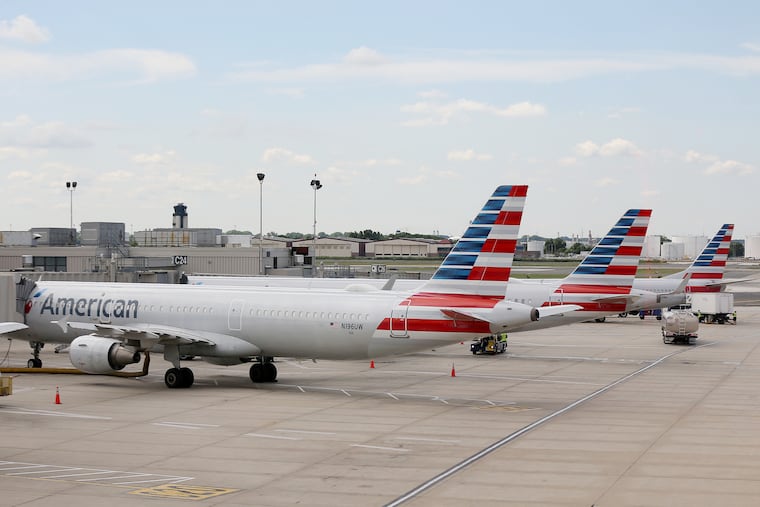COVID-19 risk on airplanes is low if these precautions are taken, Harvard study says
Filters, masks, and cleaning of high-touch surfaces all reduce the risk below that in a grocery store, the authors said.

This week, Philadelphia Health Commissioner Thomas Farley urged people to stay home for the holidays.
But contrary to widespread perception, air travel in a pandemic might not be such a crazy idea, according to a new Harvard University analysis. Researchers say the risk of contracting COVID-19 on airplanes is low — even lower than in a grocery store — provided that certain precautions are followed.
These include universal mask-wearing, screening passengers for symptoms, and the use of sophisticated aircraft ventilation systems both in the air and on the ground.
The report comes just a few weeks in advance of Thanksgiving weekend, traditionally one of the busiest travel periods in Philadelphia and beyond. But to judge from passenger numbers so far during the pandemic, holiday travel patterns this year might be altered — especially with COVID-19 case counts on the rise in most of the country.
After declining sharply in the spring, air travel increased somewhat toward the end of the summer but remains well below normal. At Philadelphia International Airport, the numbers of domestic airline passengers landing and taking off in August were 60% lower than in the same month a year ago.
Most airlines already have implemented the safety measures described in the 187-page Harvard report to some degree, said Leonard J. Marcus, one of the authors. That may explain why few, if any, cases of COVID-19 transmission aboard aircraft have been proven since mask-wearing became commonplace, he said in a media briefing Wednesday.
Those with a compromised immune system should nevertheless think twice before flying. And while air travel is relatively low-risk for most people, the risk is not zero, said Marcus, a faculty member at Harvard’s T.H. Chan School of Public Health and the Kennedy School.
“You can’t say no risk until COVID is behind us,” Marcus said. “There is always an element of risk.”
Nevertheless, airplanes are a fairly safe place to be, the Harvard team said.
The analysis, drawn from dozens of studies on such topics as viral biology, transmission dynamics, and the performance of aircraft filtration systems, was sponsored by the aviation industry. But the Harvard team agreed to conduct it only on the condition that it would be independent, Marcus said.
In addition to reviewing other studies, the researchers devised their own models, estimating the risk of transmitting the coronavirus during flights and while passengers are boarding and disembarking. A future report will focus on reducing risk in airports.
Aboard planes, much of the protection comes from the banks of HEPA (high efficiency particulate air) filters located in the belly of each aircraft, said report co-author Jack McCarthy, a Harvard-trained scientist and president of Environmental Health & Engineering, a consulting firm based in Newton, Mass. A mixture of fresh outside air and filtered, recirculated air is piped in above each row of passengers and sucked out through vents near their feet.
“It really localizes the flow,” he said.
On average, cabin air is refreshed every two to three minutes, far more often than in a typical office building or store, the authors wrote. And the HEPA filters remove more than 99% of particles of the size that can carry the coronavirus.
But ventilation alone is not enough to minimize risk to ultra-low levels in a pandemic, the authors said.
Other recommendations include:
Before each flight, passengers and crew should attest that they are free of COVID-19 symptoms and have not been exposed to anyone who has tested positive.
Passengers and crew should wear masks except when eating.
High-touch surfaces should be cleaned after each flight.
No one of these measures is foolproof, the report authors wrote. The symptom screening, for example, does not help in the event someone is infected but has yet to develop signs of illness — a common phenomenon that has bedeviled efforts to limit the spread of the virus.
The level of risk also depends somewhat on passenger compliance with mask-wearing rules and other guidance. The Harvard models assume that passengers remain seated, mostly facing forward, and are talking quietly or silent, and we have all encountered passengers who don’t meet that description — at least in the pre-pandemic era.
But these days, if passengers are intent on flouting those rules, airlines have been known to place them on no-fly lists, the report authors said. In a handful of cases, airplanes have even returned to their point of departure to discharge an unruly passenger, said John Spengler, a professor of environmental health and human habitation at Harvard’s Chan School.
“You do that a couple of times,” he said, “the word gets around.”